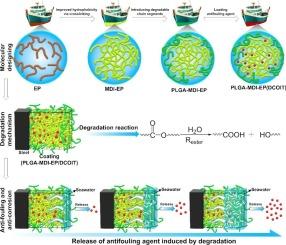Degradable epoxy-based composite coatings enhanced with PLGA for corrosion protection and controlled antifouling
IF 7.3
2区 材料科学
Q1 CHEMISTRY, APPLIED
引用次数: 0
Abstract
Marine industry continuously faces significant challenges posed by biofouling and corrosion, demanding environmentally friendly and high-performance protective coatings. In this work, we synthesized a degradable epoxy-based coating, designated as PLGA-MDI-EP, by crosslinking epoxy resin (EP-44) with diphenylmethane diisocyanate (MDI) and incorporating amorphous poly(lactic-co-glycolic acid) (PLGA). Structural characterization via FTIR confirmed the successful integration of PLGA and MDI into the epoxy matrix. Compared with pristine epoxy coatings, the developed PLGA-MDI-EP coatings exhibited markedly enhanced adhesion strength, hydrophobicity, and mechanical hardness. Electrochemical impedance spectroscopy (EIS) demonstrated superior corrosion resistance, with PLGA-MDI-EP(7.5 %) exhibiting optimal performance due to the synergistic effects of improved cross-linking density, microphase separation, and hydrolytic degradation-induced self-healing. Further, the incorporation of dichloroisocyanatobenzene (DCOIT) into PLGA-MDI-EP(7.5 %) successfully produced a composite coating (PLGA-MDI-EP(7.5 %)/DCOIT) demonstrating excellent corrosion protection and efficient, controlled antifouling agent release. This research advances the development of sustainable, degradable coatings, providing significant potential for enhancing the durability and efficiency of marine infrastructures.

可降解环氧基复合涂层,增强PLGA防腐蚀和控制防污
海洋工业一直面临着生物污染和腐蚀带来的重大挑战,要求环保和高性能的保护涂层。本研究以环氧树脂(EP-44)与二苯基甲烷二异氰酸酯(MDI)交联,并掺入无定形聚乳酸-羟基乙酸(PLGA),合成了一种可降解环氧基涂料,命名为PLGA-MDI- ep。通过FTIR进行的结构表征证实了PLGA和MDI成功集成到环氧基体中。与原始环氧树脂涂层相比,所开发的PLGA-MDI-EP涂层具有明显增强的附着力、疏水性和机械硬度。电化学阻抗谱(EIS)显示出优异的耐腐蚀性,PLGA-MDI-EP(7.5%)表现出最佳性能,这是由于交联密度、微相分离和水解降解诱导的自愈的协同作用。此外,将二氯异氰酸苯(DCOIT)掺入PLGA-MDI-EP(7.5%)中,成功制备出了一种复合涂层(PLGA-MDI-EP(7.5%)/DCOIT),具有出色的防腐蚀性能和高效、可控的防污剂释放。这项研究促进了可持续、可降解涂料的发展,为提高海洋基础设施的耐久性和效率提供了巨大的潜力。
本文章由计算机程序翻译,如有差异,请以英文原文为准。
求助全文
约1分钟内获得全文
求助全文
来源期刊

Progress in Organic Coatings
工程技术-材料科学:膜
CiteScore
11.40
自引率
15.20%
发文量
577
审稿时长
48 days
期刊介绍:
The aim of this international journal is to analyse and publicise the progress and current state of knowledge in the field of organic coatings and related materials. The Editors and the Editorial Board members will solicit both review and research papers from academic and industrial scientists who are actively engaged in research and development or, in the case of review papers, have extensive experience in the subject to be reviewed. Unsolicited manuscripts will be accepted if they meet the journal''s requirements. The journal publishes papers dealing with such subjects as:
• Chemical, physical and technological properties of organic coatings and related materials
• Problems and methods of preparation, manufacture and application of these materials
• Performance, testing and analysis.
 求助内容:
求助内容: 应助结果提醒方式:
应助结果提醒方式:


